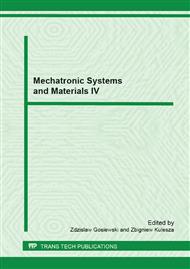p.571
p.577
p.583
p.589
p.594
p.600
p.606
p.615
p.621
The Concept of an Interactive Device for Children's Lower Limbs Rehabilitation
Abstract:
This paper presents an interactive system for childrens lower limbs rehabilitation, which aims to satisfy the essential requirements for progress in rehabilitation by stimulating a childs senses through image and sound. Brain activity measurement with an EEG sensor is used as a function steering the rehabilitation process. Through the interactive integration of the function of movement rehabilitation with mental stimulation of a child it will be possible to support the development of cognitive functions, cause-effect thinking, stimulation of the senses and to improve coordination and spatial orientation of the young patient and also encourage and motivate them to participate fully during therapy.
Info:
Periodical:
Pages:
594-599
Citation:
Online since:
March 2013
Authors:
Keywords:
Price:
Сopyright:
© 2013 Trans Tech Publications Ltd. All Rights Reserved
Share:
Citation:


